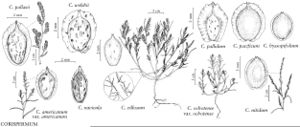Difference between revisions of "Corispermum villosum"
Bull. Torrey Bot. Club 24: 191. 1897.
imported>Volume Importer |
imported>Volume Importer |
||
| Line 64: | Line 64: | ||
|publication year=1897 | |publication year=1897 | ||
|special status=Illustrated;Endemic | |special status=Illustrated;Endemic | ||
| − | |source xml=https:// | + | |source xml=https://bitbucket.org/aafc-mbb/fna-data-curation/src/2e0870ddd59836b60bcf96646a41e87ea5a5943a/coarse_grained_fna_xml/V4/V4_611.xml |
|genus=Corispermum | |genus=Corispermum | ||
|species=Corispermum villosum | |species=Corispermum villosum | ||
Latest revision as of 21:59, 5 November 2020
Plants usually branched from the base, (5–)10–30(–35) cm, densely or sparsely covered with dendroid or stellate hairs (rarely with scattered papillae at margins of bracts), occasionally becoming glabrous. Leaf blades linear-oblanceolate, linear, or rarely narrowly linear (usually rather abruptly narrowed into mucronulate apex), usually plane, (1–)1.5–3.5 × (0.1–)0.2–0.3 cm. Inflorescences rather compact, dense, condensed in distal 1/2, occasionally interrupted in proximal 1/2, usually clavate or clavate-linear (rarely ± ovate). Bracts ovate, ovate-lanceolate, or narrowly ovate-lanceolate, 0.5–1.5(–2.5) × (0.3–)0.5–1 cm. Perianth segment 1. Fruits yellowish brown, light brown, or dark brown, usually with reddish brown spots and occasionally whitish warts, strongly convex abaxially, plane or slightly convex (occasionally slightly concave) adaxially, elliptic or obovate-elliptic, usually broadest beyond middle, 1.8–3(–3.2) × 1.5–2 mm, dull; wing absent or to 0.1(–0.15) mm wide, margins entire, apex triangular.
Phenology: Flowering late summer–fall.
Habitat: Sand dunes, sandy and gravely shores, waste places
Elevation: elevation not known
Distribution
Alta., Ont., Que., Sask., Colo., Idaho, Ill., Minn., Mo., Mont., N.Dak., Oreg., Utah, Wash., Wis., Wyo.
Discussion
Corispermum villosum may also occur in British Columbia, Manitoba, Nevada, South Dakota, and Utah. It is probably introduced rather than native in Ontario (where it is found mostly in Thunder Bay district, known for its grain elevators and mills), Quebec, and Wisconsin. Plants from Minnesota and North Dakota are transitional toward C. americanum.
Corispermum villosum is also distinguished by having style bases forming a triangular “beak” distinctly protruding over the edge of the wing/fruit. Some specimens of C. villosum are very similar to the small-fruited and narrow-winged European representatives of C. pallasii. Together with some Eurasian species, C. pallasii, C. americanum, and C. villosum belong to the same group of closely related species, and occasional transitional forms between these taxa are not uncommon in North American material.
The names Corispermum orientale Lamarck and C. hyssopifolium were commonly misapplied to C. villosum.
Selected References
None.
